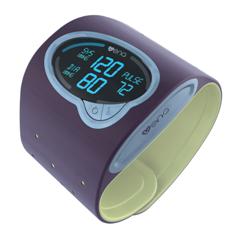Breakthrough in medical device interoperability with Vena wireless platform
31 March 2008
Cambridge Consultants has announced the first demonstration of the emerging industry standards for medical device interoperability. The 'Vena' platform is a breakthrough software solution on a single chip that allows medical devices such as blood pressure monitors to transmit data wirelessly.
The development gives consumers, especially those with chronic conditions, the ability to monitor their own health accurately, systematically and independently.
 |
|
Cambridge Consultants' vision of a consumer wrist-worn blood pressure monitor featuring the Vena platform. The device would be easy to slip on periodically during the week and then would wirelessly transfer recorded data back to a central monitor. |
The platform uses low-cost wireless technology and will allow devices to deliver medical readings to a central monitor located in the home, or even to an online health record such as Google Health or Microsoft Health Vault. The Vena software solution can be added to a medical device using hardware with a potential cost of less than US$10 at the appropriate volumes and could be available in medical devices by the end of 2008, according to Cambridge Consultants.
Online health services allow a consumer to manage their own health and fitness data securely. Controlling when and with whom the data is shared offers the potential to improve the understanding and management of their health.
"Due to both an increasingly independent mindset and time-poor healthcare providers, consumers are taking an increasingly active part in monitoring and managing their health," said Paul Williamson, Head of Wireless Medical, Cambridge Consultants. "This first successful demonstration of the platform, combined with its affordability, and compatibility, opens up a whole vista of possibilities in the way health is monitored and treated. This platform takes us one step closer to all the possibilities of next-generation healthcare."
For the first time, the Vena platform embeds both the emerging IEEE11073 standard, which ensures compatibility of data exchanged between different types of devices, and the emerging Bluetooth Medical Device Profile, optimised for the secure transport of medical data, onto the single chip.
Successfully concept tested with a pulse oximeter and weighing scales, the platform will be expanded to include other types of device including blood pressure monitors. The platform is also capable of delivering a complete display, which means that device manufacturers now simply need to add their sensor of choice and the device is wireless-ready.
The Vena platform can be used with multiple devices, providing a connection to online records through a monitoring station, home PC or set-top box. In addition to Bluetooth, the platform incorporates complete support for a range of other connections. Full TCP (transmission control protocol) implementation allows Wi-Fi or Ethernet connections. Cable connections via UART (universal asynchronous receiver/transmitter) or USB can also be added. The platform can even be used to transmit data via mobile phone for health and fitness applications on the move.
"The Vena platform can be easily built into devices at any stage of the design or production process," said Paul Williamson. "This ease of implementation makes it possible that medical devices with wireless capability could be commercially available before the end of 2008."
About IEEE 11073
IEEE 11073 Personal Health Data is a framework of standards that addresses transport-independent application and information profiles between personal telehealth devices and monitors / managers (e.g. health appliance, set top box, cell phone, personal computer). Device profiles include pulse oximeter, blood pressure monitor, weighing scale, and thermometer.
A Bluetooth profile defines how different applications use Bluetooth wireless technology to set up a connection and exchange data. The Medical Devices Working Group of the Bluetooth SIG developed the Bluetooth medical device protocol to ensure that devices in the medical environment can transfer data between devices in a secure and well defined way via Bluetooth wireless technology.